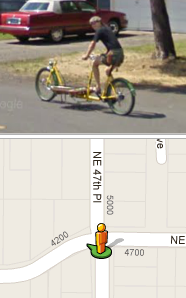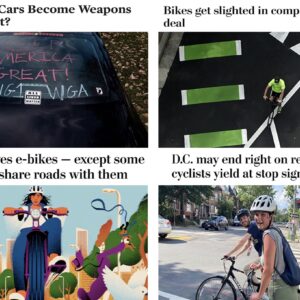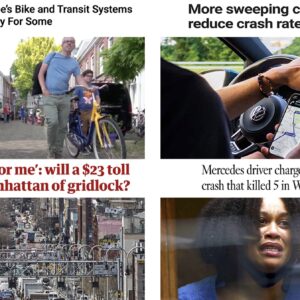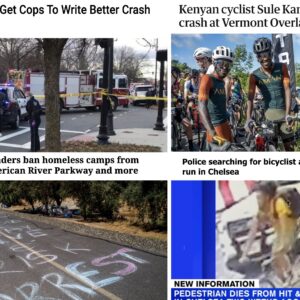
(Google Street View)
Here’s the news that caught our eyes this past week…
– New York City has designated its first residential reduced speed zone, called a neighborhood slow zone, meant to reduce the number and impact of vehicle collisions. Oregon’s 25 mph residential speed limit law goes into effect on January 1, 2012.
– After its first months in operation, Boston’s bike share program has won over the city and many former critics. Tome Keane from the Boston Globe originally thought the program was one of those “off-the-wall, goofy larks you’d find in cities like Portland, Ore.” but now says Boston’s bike share “is one of [the mayor]’s best ideas ever.”
– Reuters highlights a study which shows how the proliferation of car parking spaces may hamper the growth of a city.
– If cities highlighted in the study examined by Reuters want to convert car parking lots into bike parking, they should take a look at this award-winning design for a bike parking garage in Philadelphia. (We also hope the folks at PCC Cascade take a look at it.)
– After two years spent collecting hundreds of photographs of people and their bicycles in South Africa, Stan Engelbrecht and Nic Grobler are launching their Bicycle Portraits book on Kickstarter.
– Speaking of bicycle portraits, José Castrellón has captured photos of custom bikes, and their builders, in Panama. The makeshift customizations they’ve made to their bicycles evoke thoughts of Oakland’s Scraper Bike phenomenon.
– Strong Towns Blog covers three problems we, as Americans, are having with designing efficient, cost-effective transportation networks. One suggestion they make to address the issue: “safely accommodate the long-neglected non-auto traffic.”
– Watching this video of a dog following a rider through a bike park is going to make you want a ride mascot of your own.
– If you’re concerned about mens’ and women’s health related to bicycling and bike saddles, the Centers for Disease Control has collected some good data. Speaking of health and riding, we can’t wait for Elly Blue’s latest zine.
– We loved seeing this AP story picked up in papers across the country: “Towns turn to ‘road diets’ to slow busy traffic.”
– What’s a zoetrope? Its a device used to make still images appear as if they’re in motion. Katy Beveridge managed to build her own zoetropes using a video camera, bicycles, and paper cut-outs. It’s quite a trip to see the spinning designs along her bike wheels.
– Monique van der Vorst started her professional racing career in handcycling, but after recovering from an accident and regaining the use of her legs she will ride with the Rabobank Women’s Cycling team.
– If you haven’t seen the ITO World map of casualties on U.S. roads yet, it’s an interesting and sobering experience. As you’re examining the map, remember: each dot on the map represents a lost life.
– More good news for bikes from car-choked Los Angeles, a new brightly colored green bike lane now stretches 1.5 miles through the heart of the city.
– Is Atlanta, GA the new Amsterdam? That’s the question posed by one blogger in Atlanta, who highlights the ambitious projects underway in the city which are improving safety and comfort for people on bicycles.
– And finally, Google Street View has captured many interesting sights over the years and we can now add a cargo bike to that list. Jamie Nichols from Metrofiets was spotted riding his cargo bike near NE 47th and Alberta on Google Maps.
Did you find something interesting that should be in next week’s Monday Roundup? Drop us a line.





Thanks for reading.
BikePortland has served this community with independent community journalism since 2005. We rely on subscriptions from readers like you to survive. Your financial support is vital in keeping this valuable resource alive and well.
Please subscribe today to strengthen and expand our work.
Wow, if parking spaces inhibit population growth, then Reuters has just made the best argument ever for putting in more parking lots in Portland.
They seem to be only measuring “growth” by population.
You seem to be inferring that all growth is bad.
I adhere to the “Agent Smith”-esq belief that our society has internalized a growth centric way of life that is ultimately self defeating.
Despite this i believe that some internal expansion is not bad.
I believe that the point of the Reuters article, and the Atlantic and original UC paper, is that parking spaces are historically and empirically counter-indicated as needed for population growth.
I will go further and suggest that if a study of a region includes economic growth it will show that parking spaces cap the overall GDP for that region and decrease tax revenue. This should be related to a decrease in square footage available to perform commerce related activities and the commensurate decrease in taxable income from a parking lot.
We should also expect that quality of life issues are inversely proportional to parking spaces.
I’m not suggesting all growth is bad. Economic growth is good. But Oregon has, for all practical purposes, static economy: it doesn’t grow proportionally with population. That’s been true since the days Hatfield was governor. Given this economic atmosphere, population growth is only good if the goal is to make everyone’s slice of the economic pie in Oregon smaller.
Where are you getting your data from, Paul? Oregon’s GDP has grown exponentially in relation to population growth – hardly “static”
Year GDP POP
1970 9.80 2.10
1980 30.0 2.64
1990 56.6 2.86
2000 113.0 3.43
2010 174.2 3.83
GDP in Billions of $, Pop in millions of people
If you plot the points on a linear scale for Pop and an exponential scale (squared values) for GDP, the lines will remain almost parallel. And that’s since 1970, 3 years after Hatfield.
Cost of living has outstripped GDP in Oregon. As the population increases, it strips away any GDP gains.
The ITO World map is quite interesting… should really help with advocacy given that the number of green dots is small and the number of purple dots is huge.
I look at my own Corvallis and Albany area on the map and am disturbed to see that the city streets carry far more blue and green markers than purple ones. And I know the names behind many of these markers.
It doesn’t help much that even in the college towns, once you leave Portland, Oregon is an overwhelmingly bicycle-hostile state. Eugene and Corvallis are less hostile than most areas, but in those towns, many people who bike don’t do a whole lot to really help their own cause (I’ve been hit twice in Eugene and once in Corvallis by bicycles operating unlawfully and in an unexpected manner, and I don’t spend much time in those towns!). The maps seem to indicate, for the most part, that my theory that motorist compliance is higher outside the Metro Region, isn’t entirely unsound (or, at least, doesn’t result in as many fatalities).
I lived in Atlanta for 17 years before moving to Portland 3 years ago. Atlanta has 20+ years of work to do to make the city even the least bit bike friendly. It is probably one of the least bike (and pedestrian) friendly cities in the nation.
Kudos to them for starting down the path. Let’s hope they keep it up for the next couple of decades.
After being almost run down by numerous speeding vehicles in the rain this weekend…
I wonder why when the safety flag goes up, no one EVER talks about saving lives by lowering speed limits.
And while I’m up on this soap box…
So I’m stopped waiting to turn left into our garage on a two-way street (in a car). I have my left turn signal on. A car is emerging from the one-car-wide exit, turning right, to go the opposite direction of me. There is a double yellow line painted in the center of the road.
Not one, but TWO motorists behind me proceed to drive around me, in the wrong lane, illegally, into oncoming traffic, on the side I am signaling to turn, preventing both the driver from exiting and myself from clearing the traffic lane.
Seriously, what is wrong with people?
Agreed – I *hate* to get on the whole “it seems so much worse these days” bandwagon, because people have been saying that for ages, but people seem to severely lack both patience and civility these days. I notice the “drive around a car waiting to turn” thing all the time as well, despite it being illegal AFAIK.
Perhaps it is worse now. I blame the internet, mobile phones, the 24 hour news cycle, always-on-and-connected-everything, facebook, and Ronald Reagan.
Problem is, many motorists rarely, if ever, obey the speed limit to start with. Supporting this theory, the mere prevalence of radar detectors marketed to scofflaw motorists.
Yeah I’m actually surprised radar detectors are legal.
Loved reading this Monday Roundup. The South Americans and their bikes are awesome.
Go Lily!!! There is nothing quite as much fun as riding with your dog.
“Oregon’s 25 mph residential speed limit law goes into effect on January 1, 2012” – Actually the law allows reduction of the speed limit from 25 to 20 mph where the specified criteria are met.
Bicycle parking garages would never work. There simply are not enough cyclists that are willing to pay enough money for the garage to come out ahead. Bikes would have to pay perhaps $15 a day = – . Cyclists just aren’t going to pay. =Failed idea. Unless the project is an entitlement. Perhaps Obama will borrow more money from the Chinese to spearhead these projects all across the country, we could spend untold billions on this that won’t have to be paid back until your child is old enough to pay taxes…
I have been suggesting a lower residential speed limit for TX for years, but the law still states the lowest permanent speed limit allowed in TX is 30 MPH unless the road belongs to the federal Govt. or is a private road, as in a gated community. the lowest school zone allowed in TX is 20 MPH. When I was a kid living in military housing the speed limit was 15 MPH, and the few times I have been to bases since then the limits are still 15 MPH with 10 MPH school zones.
Needless to say I’m jealous of your 25 MPH and lower limits.
Just about died laughing the first time I hit the school zone between Tulsa and Bixby on US 64 and seeing “SCHOOL SPEED LIMIT 60 WHEN CHILDREN ARE PRESENT” sign in a 70 zone…
We visited our son in Boston. My jaw dropped at the number of bicycles downtown compare to the sparse few 3 years ago. I even have a photo of the bikeshare stand near the green.
Nice! I’d love to see the photo of the bike share system. I’ve visited one in Chicago but I haven’t seen Boston’s in person.